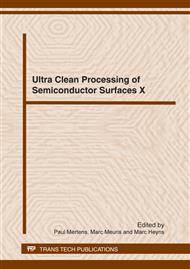p.3
p.9
p.15
p.19
p.23
p.27
p.33
p.37
Optimized Post-CMP and Pre-Epi Cleans to Enable Smooth and High Quality Epitaxial Strained Ge Growth on SiGe Strain Relaxed Buffers
Abstract:
Further improving complementary metal oxide semiconductor (CMOS) performance beyond the 15 nm generation likely requires the use of high mobility materials like Ge for pMOS devices. However, Ge pMOS devices made in relaxed Ge do not outperform current state of the art uni-axially strained Si pMOS devices. This explains the current interest in compressively strained Ge like bi-axially strained Ge grown on top of SiGe Strain Relaxed Buffers. From a device integration point of view, the surface smoothness of the strained Ge layer is an important parameter which has so far not widely been reported in literature, in contrast to other parameters like the material quality (crystallinity) and the threading dislocation density. In this paper we report the post-CMP and pre-epi cleans which are required to obtain contamination free SiGe surfaces to enable defect free strained Ge growth without reoccurrence of the surface roughening. We will demonstrate the epitaxial growth of fully strained 20 nm thick Ge epitaxially grown on top of SiGe Strain Relaxed Buffers with 85% Ge with a surface roughness as low as 1.6 Å (as measured on areas of 10×10 µm2).
Info:
Periodical:
Pages:
15-18
Citation:
Online since:
April 2012
Authors:
Price:
Сopyright:
© 2012 Trans Tech Publications Ltd. All Rights Reserved
Share:
Citation:


